Birdfinding.info ⇒ Locally common along the rugged North Atlantic coasts where it breeds and as a winter visitor to coastal waters of western Europe and eastern North America. Widespread as a breeding bird in the Canadian Maritimes, Iceland, Ireland, Scotland, and Wales. In the U.S. it can be seen in summer around Bar Harbor, Maine, or on excursions to seabird colonies such as Machias Seal Island; and in winter at various seawatch points in the Northeast, including Cape Ann, Race Point, and Montauk, and on winter pelagic trips out of ports south to Virginia Beach, Oregon Inlet, and Hatteras.
Razorbill
Alca torda
Breeds on North Atlantic coasts and disperses to adjacent waters.

Approximate distribution of the Razorbill. © Xeno-Canto 2022
Breeding. Breeds from March to August in large colonies on sea cliffs and islets along the coasts of northeastern North America (locally from southeastern Baffin Island and northern Quebec south to Maine), southwestern Greenland, Iceland, Jan Mayen, Bear Island, Fenno-Scandia (locally throughout, including the Baltic and Russian White Sea coasts), Faeroes, the British Isles, and a few points in continental Europe from Denmark to Brittany.
Adults return to colonies in March and lay their eggs from mid-May to mid-June. Juveniles depart by early or mid-August.

Razorbill pair at breeding colony on Machias Seal Island, Maine. (June 12, 2021.) © Herbert Fechter
The largest breeding concentrations are on and around (1) Iceland and (2) the British Isles. Each supports approximately 100,000-200,000 pairs, together comprising about 80% of the global population. The remaining 25,000-50,000 pairs are about evenly divided between eastern North America (plus Greenland) and Europe.
Nonbreeding. Winters at sea across upper latitudes of the North Atlantic north to Labrador, Norway, and the Baltic Sea, and south to North Carolina, central Morocco, and the western Mediterranean (east to the Rhone Delta).
Smaller numbers winter irregularly south to Florida (both sides), and up the St. Lawrence River to Lake Ontario.
Exceptional vagrants have been recorded from Louisiana, Mississippi, Alabama, Bermuda, the Azores, Western Sahara, and Mauritania.
Identification
Distinctive: a large, robust, black-and-white auk with a thick neck and a laterally-compressed “razor” bill. The bill has three or four vertical grooves, and is all-black except that a middle groove shows as a pure-white line.
Breeding plumage is crisply defined: black upperparts contrast with all-white underparts—the same pattern as on Common and Thick-billed Murres (for a detailed comparison, see below). A prominent horizontal white line runs from the eye to the top of the bill, and the wing has a narrow white bar (white secondary tips).

Razorbill in breeding plumage. (Farne Islands National Nature Reserve, Northumberland, England; July 12, 2019.) © Joshua Brown
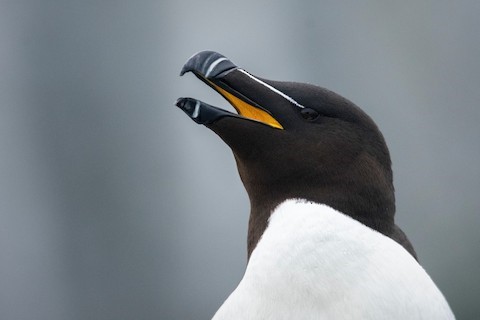
Razorbill in breeding plumage, showing its striking yellow gape. (Machias Seal Island, Maine; July 8, 2021.) © Jesse LeBlanc
Nonbreeding plumage is similar to breeding, except that the neck is mostly white and the borders between white and black are smudgy. The face remains mostly black, but the white of the neck extends up behind the eye forming a prominent ear-patch or partial collar across the hindcrown.
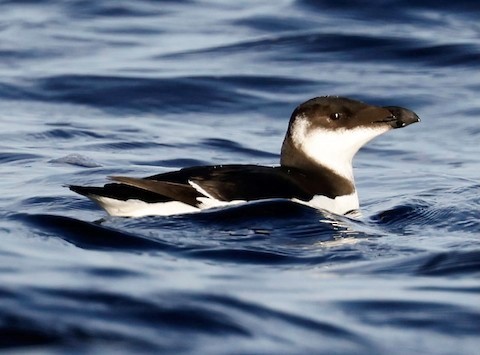
Razorbill in first-winter plumage, showing thin all-black bill. (Constance Bay, Ottawa, Ontario; October 11, 2021.) © Jeff Skevington
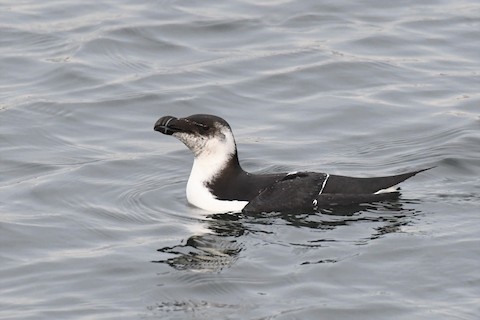
Razorbill in nonbreeding plumage. (Fort Adams State Park, Newport, Rhode Island; January 2, 2019.) © Tim Metcalf
In flight, the underside of the wing appears crisply bicolored: all-white lesser and median coverts contrast with darker flight feathers and greater coverts.

Razorbill in nonbreeding plumage. (Offshore from Oregon Inlet, North Carolina; February 28, 2021.) © Chris Thomas

Razorbill in breeding plumage, ventral view showing all-white lesser and median underwing coverts. (Eastern Egg Rock, Maine; June 14, 2018.) © Corey Husic
Notes
Polytypic species consisting of two recognized subspecies.
See below for a comparison of the Razorbill with the Thick-billed Murre.
Cf. Thick-billed Murre. The Thick-billed Murre is peculiarly intermediate in appearance between the Common Murre and the Razorbill. As all three occur together in much of the North Atlantic, and even share some of the same breeding colonies, identification at a distance often depends on discerning small details that differ among them.
Bill Shape: If seen clearly, the adult Razorbill’s bill is distinctive in both shape and pattern, but in some conditions it can be mistaken for Thick-billed. Both can appear thick and blunt, and both have a horizontal white stripe—but the Razorbill’s stripe is near the top whereas Thick-billed’s is in the middle. The subadult Razorbill’s bill has nearly the same profile as a Thick-billed Murre’s, so bill shape alone can be misleading without a clear view.
Nonbreeding Plumage: Thick-billed Murre and Razorbill have nearly identical breeding plumages, including the tone of the upperparts (both are blacker above than Common Murre). Nonbreeding plumages differ distinctively, however, as Thick-billed retains more extensive black on the head, whereas Razorbill has a large white ear-patch (thus resembling Common Murre).
More Images of the Razorbill
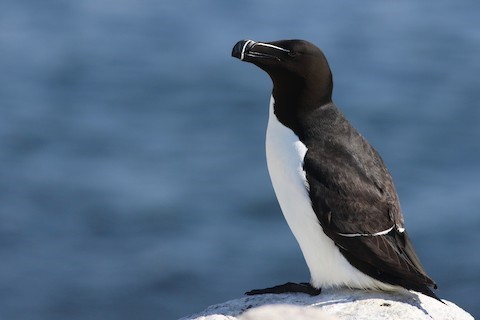
Razorbill in breeding plumage. (Seal Island National Wildlife Refuge, Maine; July 3, 2017.) © Keenan Yakola
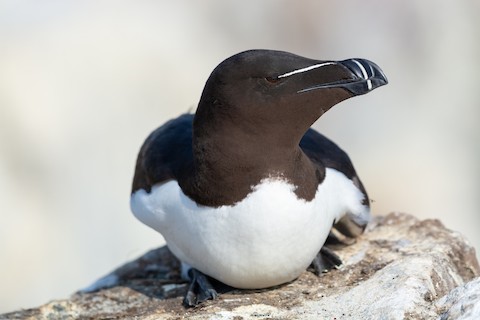
Razorbill in breeding plumage. (Farne Islands National Nature Reserve, Northumberland, England; July 12, 2019.) © Joshua Brown

Razorbill in first-winter plumage. (Constance Bay, Ottawa, Ontario; October 11, 2021.) © Jeff Skevington
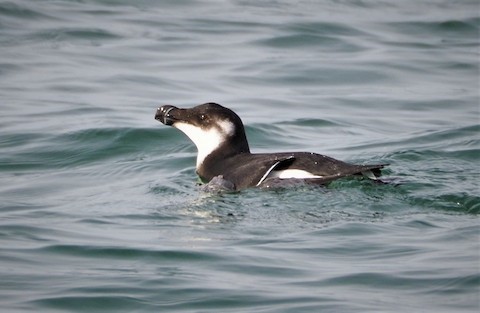
Razorbill in nonbreeding plumage. (Lake Montauk Inlet, New York; January 1, 2021.) © Dick Cartwright
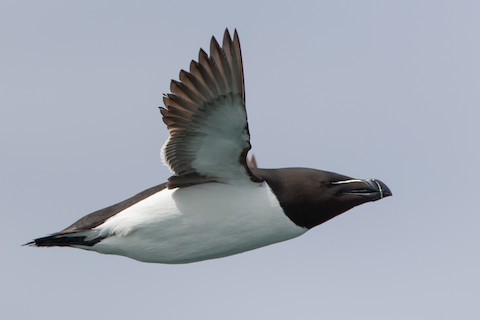
Razorbill in breeding plumage. (Machias Seal Island, Maine; June 3, 2015.) © Glenn Lahde

Razorbill in breeding plumage. (Machias Seal Island, Maine; June 3, 2015.) © Glenn Lahde
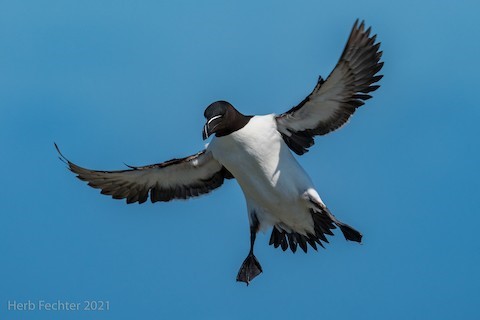
Razorbill in breeding plumage, ventral view showing all-white lesser and median underwing coverts. (Machias Seal Island, Maine; June 12, 2021.) © Herbert Fechter
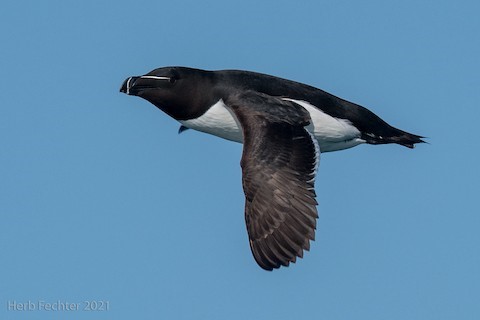
Razorbill in breeding plumage. (Machias Seal Island, Maine; June 12, 2021.) © Herbert Fechter

Razorbill in breeding plumage, ventral view showing all-white lesser and median underwing coverts. (Machias Seal Island, Maine; May 29, 2015.) © Steve Tucker
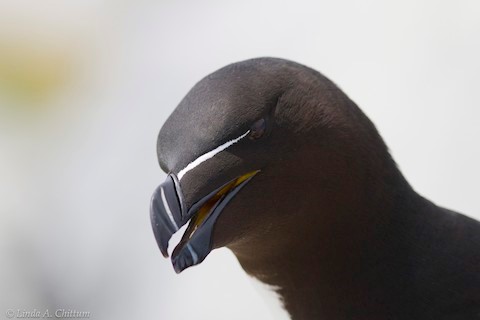
Razorbill in breeding plumage—facial close-up showing white line from eye to bill. (Machias Seal Island, Maine; June 25, 2012.) © Linda Chittum
References
Alderfer, J., and J.L. Dunn. 2014. National Geographic Complete Birds of North America (Second Edition). National Geographic Society, Washington, D.C.
BirdLife International. 2021. Alca torda. The IUCN Red List of Threatened Species 2021: e.T22694852A206142333. https://dx.doi.org/10.2305/IUCN.UK.2021-3.RLTS.T22694852A206142333.en. (Accessed January 6, 2022.)
eBird. 2022. eBird: An online database of bird distribution and abundance. Cornell Lab of Ornithology, Ithaca, N.Y. http://www.ebird.org. (Accessed January 6, 2022.)
Gaston, A.J., and I.L. Jones. 1998. The Auks: Alcidae. Oxford University Press.
Harrison, P. 1983. Seabirds: An Identification Guide. Houghton Mifflin, Boston.
Howell, S.N.G., and K. Zufelt. 2019. Oceanic Birds of the World. Princeton University Press.
Sibley, D.A. 2014. The Sibley Guide to Birds (Second Edition). Alfred A. Knopf. New York.
Svensson, L., K. Mullarney, and D. Zetterström. 2009. Birds of Europe (Second Edition). Princeton University Press.
Xeno-Canto. 2022. Razorbill – Alca torda. https://xeno-canto.org/species/Alca-torda. (Accessed January 6, 2022.)

